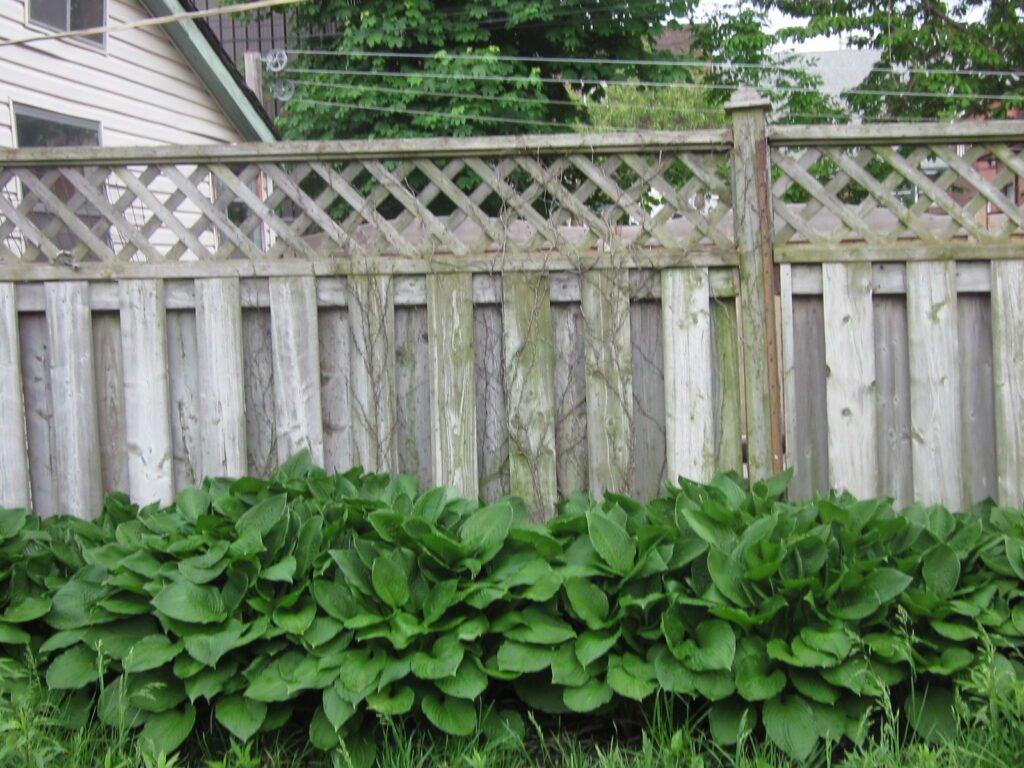
Hostas along a east/west fence of about 20 feet seem to have outgrown their space, and are in need of a haircut, like a lot us. I’m sure they grew to about four feet last year, without my giving them any attention, except keeping the pathway near them clear. The pathway borders a larger area I have covered with black plastic as I solarise that area for mulching, for future plans.
The intention was to overshadow the fence separating two separate homes, saving a few for the return to another space.
At this time of the year in west end Toronto, do I have the choice of thinning them, or should I wait until September, since they seem to be growing more than I wanted, and will require more disposal later, than now.
I also want to plan my time around higher maintenance plants.
Last summer and this spring have been odd times for hostas, for sure. A couple of my hostas put out new bloom scapes in October/November, which I have not experienced before, and this year all my hostas are larger than anticipated, even the ones in pots. I’m glad I’m not the only one experiencing this surge in hosta growth this year. But it is a nice problem to have!
The conventional wisdom on hosta division is to divide every three years or so. However, if you have chosen your initial site wisely and provided adequate care at planting time and proper subsequent maintenance, hostas can remain in place without division for many years, growing to their full potential (which is often much larger than people expect – pay attention to the dimensions on the plant tags and add up to 6-12 inches/15-30 cm, or more). They only require division if the middle of the plant is starting to die out. I have had a hosta remain in place in the ground for 15+ years without significant division; others have been thriving in pots for about 5+ years. Mostly I divide them only in order to pass on plants to neighbours and friends. My neighbours have had an untouched close-planted miniature hosta “hedge” for about seven or eight years – each year, these hostas delight passers-by with their sea of August-flowering pale purple scapes.
Hostas, like many other perennials, are best divided in spring (when new growth appears) or in fall (when the plant starts to go dormant). Please see below our Gardening Guide on dividing hostas and other perennials.
However, if you simply CANNOT wait for these times, then consider that hostas are generally hardy and fairly forgiving plants. Especially if you divide them really soon before real summer heat sets in, and keep the divisions in full shade, they may be OK (however, we cannot guarantee that this will be the result).
In order to thin your plants, a good approach might be to first water the plants thoroughly a couple of days before. Do this on a sunny day when rain is not expected, and early in the day – to deter slugs and snails. Prepare your planting holes or pots for the divisions ahead of time, mixing some compost either into your garden soil or into potting soil in pots. Water the soil or pots deeply.
Early in the day of division, plunge a flat-bladed spade into a section of the crown, and separate out a portion of the plant. This allows the main plant to continue to thrive; it may be a little odd-shaped the following year (i.e. not completely circular) but this would be disguised by the close neighbouring hostas in your bed, and the plant likely will resume its circular shape within a couple of growing seasons. Make sure to get a decent-sized section of plant that includes several “eyes”. See the below link for dividing and potting up hosta divisions. You should probably trim some of the roots (to encourage feeder roots to develop) and cut off all but one or two of the youngest leaves (this allows the plant to continue to manufacture food through the remaining leaves, but reduces moisture evaporation through foliage). Do not fertilize the divisions, and keep them in full shade (moist but not soggy) until they start to show good regrowth with a number of new leaves. They can then be repotted or transplanted into the garden.
Happy gardening; good luck with your hosta division whether you decide to tackle this soon or wait until the fall.
Sidenote 1: instead of discarding your hosta divisions, you may want to put them out on the sidewalk (even in plastic bags if you don’t have pots) – I also live in west-end Toronto, and find that people appreciate free plants :)
Sidenote 2: solarizing an area is a generally accepted strategy to kill unwanted weeds and invasive plants, but please note that it also destroys beneficial fungal mycorrhizae and other organisms in the soil. Before planting that area, add lots of compost or other organic mulches to the top of the soil. Unnecessary digging can bring unwanted weed seeds to the top of the soil, and can also further destroy mycorrhizae and other beneficial micro-organisms.
https://www.nhhostas.com/dividing-hostas/
https://www.bhg.com/gardening/flowers/perennials/how-to-divide-hostas/

